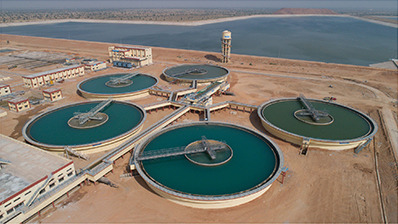ODA Topics 4
The 4th Asia-Pacific Water Summit

Water treatment facility constructed under the “Rajasthan Rural Water Supply and Fluorosis Mitigation Project” in the Nagaur district of Rajasthan in northwest India. This ensured safe and stable drinking water supply services. (Photo: Public Health Engineering Department, Government of Rajasthan)

Beginning of the HSG Meeting (Photo: Japan Water Forum)
Water is a blessed resource that underpins our society. In the form of natural disasters, however, it can pose a threat to human life and prosperity. For example, in recent years, the frequency of water-related disasters has been increasing across the world. In Japan, the frequency of torrential rains has increased by approximately 40% compared with 30 years ago, and in the Asia-Pacific region, the number of water-related disasters impacting large populations Note 1 has nearly tripled over the past 30 years. Besides water-related disasters, water is deeply related to a range of challenges in society such as poverty, public health, food, the environment, energy, and peace and security.
The Asia-Pacific Water Summit is a high-level international conference for top government leaders from the Asia-Pacific region, with the aim of deepening awareness of water issues and encouraging concrete resource mobilization and initiatives. The 4th Note 2 Asia-Pacific Water Summit was held in Kumamoto City, Japan, on April 23 and 24, 2022. It was the first time in 15 years that the Summit was held in Japan. Approximately 5,500 participants attended the Summit both in-person and online, with participation by leaders and ministers from 31 countries in the Asia-Pacific region, including Japan. Prime Minister Kishida participated in the Summit from Japan, and held luncheons and bilateral meetings with the leaders of the countries in attendance. The theme of the Summit was “Water for Sustainable Development: Best Practices and the Next Generation,” and discussions were held to reaffirm the importance of water in the process of recovery from COVID-19 and to continue sustainable development for future generations.
The opening ceremony featured online remarks and a commemorative speech by His Majesty the Emperor of Japan. Prime Minister Kishida delivered the keynote speech at the Heads of State and Government (HSG) Meeting held in the afternoon, stating that Japan would make proactive efforts, including the development of “quality infrastructure,” toward resolving social issues related to water, while coordinating and cooperating with various countries and international organizations. He also announced the “Kumamoto Initiative for Water,” Japan’s measures to contribute toward resolving water issues. Moreover, during the HSG Meeting, the leaders of the participating countries announced the “Kumamoto Declaration.” Note 3 The Chair’s Summary was announced on the second day, April 24, compiled based on the active discussions among the participants from various countries and organizations over the two days.
At the closing ceremony, a representative of youth from the Asia-Pacific region (India) together with a high school student from Fukuoka Prefecture delivered the “Message from Youth” in which they conveyed the importance of cooperation between youth and adults and reaffirmed the importance of strengthening youth participation in regional sustainable development.
As an old saying goes, “the one who governs water governs the country.” Nowadays, governing water greatly contributes to the resolution of social issues on a global scale. The outcomes of the Summit, which was attended by the leaders of many countries, are not limited to the Asia-Pacific region. They are expected to provide significant strength and wisdom for future discussions on global water issues as well as disaster risk reduction and climate change. The outcomes are also expected to be an important input to the UN Water Conference, which is scheduled to take place in March 2023 for the first time in 46 years.
Note 1: Refers to a flood that affects 1,000 or more people.
Note 2: The first Summit was held in Beppu City, Oita Prefecture, Japan in 2007, the second was held in Thailand in 2013, and the third was held in Myanmar in 2017.
Note 3: In order to accelerate efforts in water-related fields, the Declaration calls for substantial actions for change and improvement in three fields: governance, finance, and science and technology.
